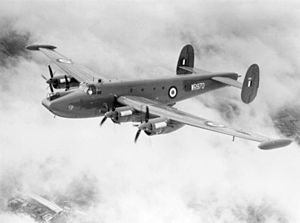Avro Shackleton
| Shackleton | |
|---|---|
 |
|
| Avro Shackleton MR3, in 1955 | |
| Role | Maritime patrol aircraft |
| Manufacturer | Avro |
| First flight | 9 March 1949 |
| Introduction | April 1951 |
| Retired | 1991 |
| Primary users |
Royal Air Force South African Air Force |
| Produced | 1951–1958 |
| Number built | 185 |
| Developed from | Avro Lincoln |
|
|
|
|
|
|
|
|
The Avro Shackleton was a British long-range maritime patrol aircraft used by the Royal Air Force (RAF) and the South African Air Force (SAAF). It was developed by Avro from the Avro Lincoln bomber, itself being a development of the famous wartime Avro Lancaster bomber. It was replaced by Nimrod maritime patrol aircraft in the 1970s. The aircraft was also adapted for airborne early warning (AEW) roles within the RAF, replaced by the Boeing E-3 Sentry in 1990. The type is named after the polar explorer Sir Ernest Shackleton.
Entering service with the RAF in 1951, the Shackleton was used primarily in the anti-submarine warfare (ASW) and maritime patrol aircraft (MPA) roles; it also became used as a search and rescue (SAR) platform and for performing several other secondary roles such as being a troop-transport. In later life, a small number of the RAF's Shackletons were subsequently adapted for airborne early warning (AEW) duties, performing in this capacity until the type's retirement in 1991. The Shackleton was also procured by South Africa, and was operated by the SAAF between 1957 and 1984.
The Battle of the Atlantic was a crucial element of the Second World War, in which Britain sought to protect its shipping from the German U-boat threat. The development of increasingly capable diesel-electric submarines had been rapid, in particular the snorkel virtually eliminated the need for submarines to surface while on patrol. Aircraft that had once been highly effective submarine-killers had very quickly become incapable in the face of these advances. In addition, lend-leased aircraft such as the Consolidated B-24 Liberator had been returned following the end of hostilities. Several Avro Lancasters had undergone rapid conversion – designated as Maritime Reconnaissance Mk 3 (MR3) – as a stopgap measure for maritime search and rescue and general reconnaissance duties; however, RAF Coastal Command had diminished to only a third of its size immediately prior to the Second World War.
...
Wikipedia
